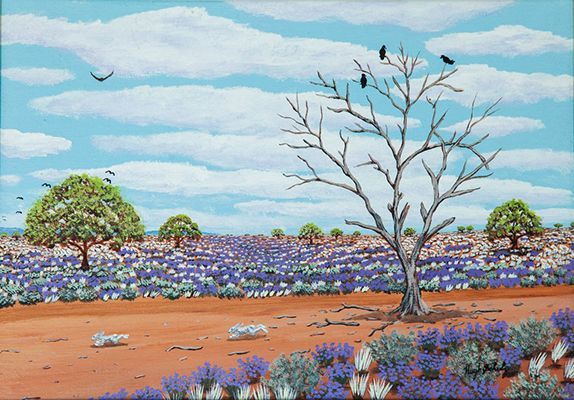The Magic of Hugh Schulz: Part 2


In 1982 a young man called Andrew was given a book of Banjo Paterson poems illustrated by Brushman of the Bush - Pro Hart1.
Andrew recounts: Those images opened my eyes to art and sent me on this journey which has been ongoing for some forty years. Up to that point wild horses couldn't have dragged me into an art gallery . Three months later I had my first painting , not only a painting but a Pro Hart painting which led me to learn about Broken Hill and discover the other artists who came from this remote part of the world.
Hugh's work didn't initially appeal to me at this time and it was not until I took my first trip to Broken Hill that I discovered the amazing landscape and all of a sudden Hugh's paintings made sense.

Andrew explains: The discovery of Pro Hart led me to a group of five artists which had become well known as the Brushmen of the Bush. Of these, two of the lesser recognized ones - Hugh Schulz and John Pickup - really stood out for me: both very different. John for the drama in his paintings and Hugh for his amazing depiction of the desert in his own naive, but colourful and warm way.


Andrew continues his story: In February 1986 I was able to purchase the first of my Hugh Schulz paintings - "Outback" from the Duke of Wellington Gallery in Sydney.

At first when you look at this painting it is a blaze of contrasting colours. But look closer and you will spy some rabbits and birds. I will let Andrew tell you more about the narratives within the images but first let's hear more about how the collection started.
Andrew continues: And then in June 1986 I purchased "Road in the Outback Hills" from the annual art exhibition held at St. Joseph's College, Sydney. These paintings became my pride and joy.

In this painting (above) there are the characteristic Schulz blaze of contrasting colours and narrative.
But take time to look carefully because: One of Hugh's quirky things was to conceal animals in the landscape. In "Road in the Outback Hills" the narrative and complete composition is lost to viewers who fail to notice the camouflaged emus on the road as they take on the same tone and texture of the earth.
Andrew shares the recollection: It was not until a trip to Broken Hill in 1991 that I met Hugh at his gallery, a gentle, quietly spoken man, and was immediately taken by the passion that he had for the desert and the surrounding area.
It was also on this trip and subsequent trips to Broken Hill that I began to not only appreciate the beauty of the desert but the beautiful way that Hugh was able to portray it. His paintings put a smile on my face every time that I looked at them.
The humour in Hugh Schulz's perception of nature is no more evident than in Coming Storm Out West where the vegetation and the sheep have been painted with a great similarity of shape, colour and texture. I can imagine why Andrew smiles each time he spends time in front of one of his paintings.

And with his gift of expression Andrew gives us an insightful description of what you will discover if you take the time to explore the narrative of a Hugh Schulz painting:
They make me feel that I could step into them: to see the eagles soaring overhead, to see the emus scampering away, to see the rabbits hiding behind the saltbush, to see the galahs, the corellas, the crows (ravens) amongst the spectacular desert vegetation, plants of many shades of blue and green, not to mention the wildflowers all surrounded by the mineral hills of all sizes and colours, the sharp blue skies, sometimes turning into menacing approaching storm clouds. You sense it in such a way that it's almost intoxicating, you can feel it, smell it, taste it.


I have been fortunate enough to acquire a few more of Hugh's paintings over the years, though they are certainly becoming rarer. To me, Hugh Schulz, in his own wonderful, highly detailed naive way, is my "Van Gogh" of the Australian outback.
Hopefully my passion will encourage other art lovers to discover the wonderful art of Hugh Schulz.
Andrew 5

©All works by Hugh Schulz displayed here have been done so with the permission of Sandra Lindeman, daughter of Hugh Schulz. Sandra has also given generous support in providing images of Hugh Schulz paintings from the family collection plus sharing background information on her father.
Thank you to Andrew from the Hunter Region for sharing his collection of Hugh Schulz paintings and for the enormous amount of work contributed to producing these posts for the AnArt4Life blog.
Thank you also to Eileen Wright, Collections Project Manager at the Broken Hill Regional Art Gallery, for providing the images of the Hugh Schulz paintings held in the Broken Hill Gallery.
If you missed it please follow this link to The Magic of Hugh Schulz: Part 1.
Footnotes and Credits
1. Poems of Banjo Paterson illustrated by Pro Hart, Lansdowne Press, Dee Why, 1982.
2. Image provided by the Broken Hill Regional Art Gallery from their collection and with the assistance of Eileen Wright, Collections Project Manager.
3. Permission to display provided by John Pickup.
4. From the collection of Andrew from the Hunter Region of NSW.
5. I live on a small farm in the Hunter Region of New South Wales which I now refer to as an "Aged Care Facility" for alpacas, while also being employed as a support worker for one of the providers under the NDIS scheme. The majority of my previous employment was in the travel industry in Sydney and London.

